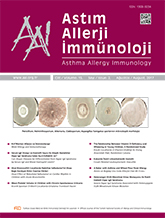


Objective: High serum IgE and eosinophil counts are laboratory features of severe atopic dermatitis (AD), persistent food allergies and severe allergic asthma as well as some primary immune deficiencies (PID), especially hyperIgE syndrome (HIES). Our objective was to define cut-off values to discriminate atopic diseases and HIES by comparing serum IgE, eosinophil levels, allergen sensitizations among patients with AD, IgE-mediated food allergy, allergic asthma and/or rhinitis, chronic granulomatous disease and HIES.
Materials and Methods: A total of 315 patients were enrolled into the study. We evaluated serum IgE (IU/L) and eosinophil (/mm3) values, allergen sensitizations and the age range of patients. ROC curve analysis was performed in order to define an optimal cut-off value for serum IgE levels and blood eosinophil counts.
Results: The median levels of serum IgE and eosinophils were 2542 (min:1, max:55400) and 1000 (min:0, max:37880), respectively in the PID group. In the atopy group, the median serum IgE was 265 (min:4, max:7122), and median eosinophil count was 400 (min:0, max:6050). Serum IgE and blood eosinophil levels were significantly higher in PID patients compared to those with atopic diseases (p<0.001 and p<0.001, respectively). IgE was statistically higher in the food allergy group compared to only house dust mite sensitized and/ or grass co-sensitized patients (p=0.008 and p=0.01, respectively). If the IgE cut-off values for HIES are considered to be equal to 2000 IU/l, the sensitivity accounted for 74% and the specificity for 96% (PPV:74%, NPV:96%). When serum IgE=5000 IU/l was considered as the cut-off, the sensitivity decreased to 56% in contrast to the specificity increasing to 99% (PPV:91%, NPV:94%). Similarly, for eosinophils=1500/mm3, the sensitivity was %51 and the specificity 96% (PPV:61%, NPV:93%) and for eosinophils=2500/mm3, the sensitivity was 41% while the specificity was 98% (PPV:76%, NPV: 92%) to discriminate HIES from atopic diseases.
Conclusion: It is possible to discriminate atopic diseases from HIES when the cut-off values are used are 2500 IU/l for IgE and 1500/ mm3 for eosinophils with ROC curve analysis. An atopic disease is the most likely underlying condition below these values. Moreover, patients with serum IgE higher than 5000 IU/l and/or blood eosinophils higher than 2500/mm3 should be managed as HIES unless otherwise proven.